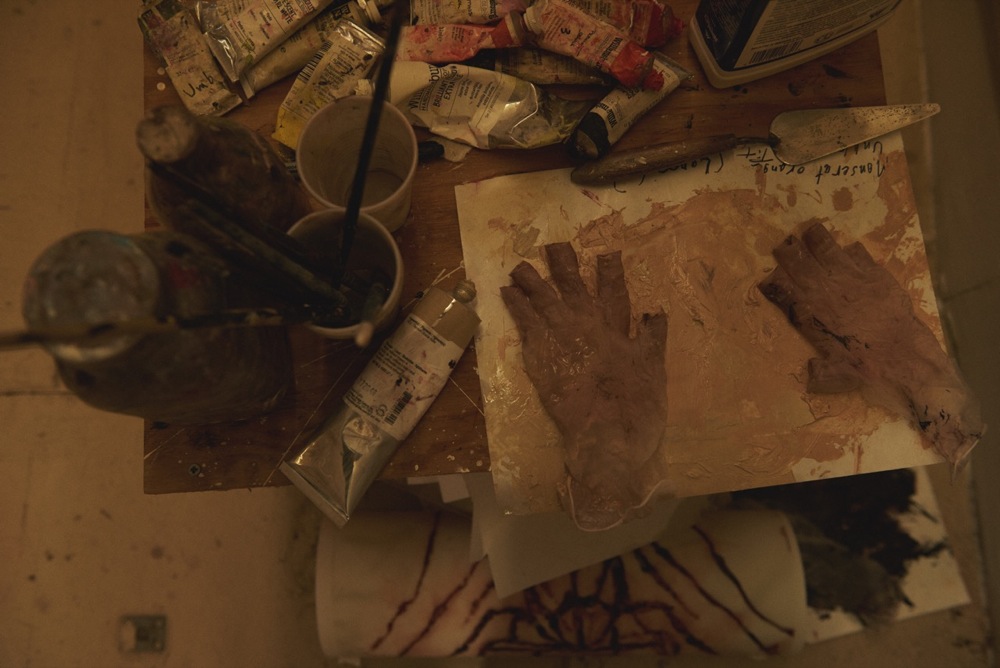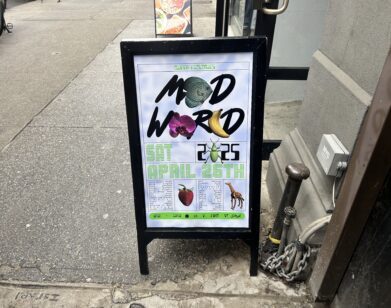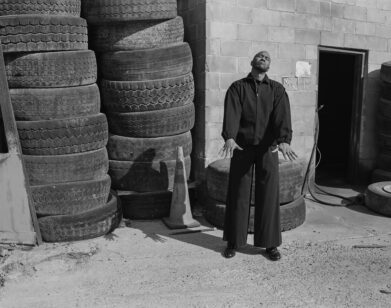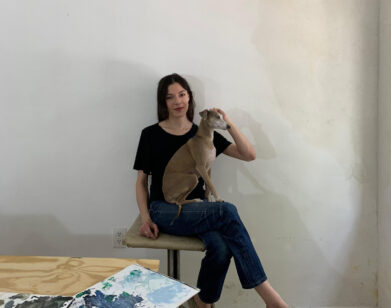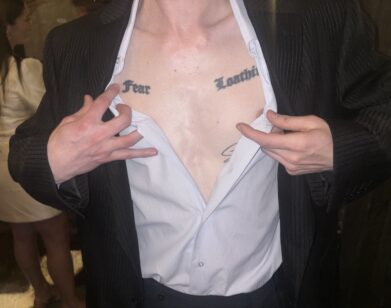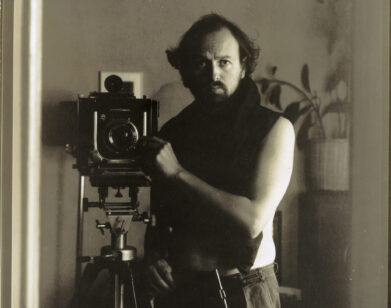Ida Applebroog, From Then to Now
IDA APPLEBROOG IN HER NEW YORK STUDIO, MAY 2016. PHOTOS: HANS NEUMANN.
At 86 years old, Ida Applebroog is celebrated for her figurative paintings, sculptures, and films that evoke discourse surrounding gender, sexual identity, politics, and violence. Before the age of 45, however, she was Ida Horowitz, a struggling artist and mother of four. Raised in the Bronx, she had moved from New York to Chicago to San Diego. In 1969, she checked herself into the mental ward at Mercy Hospital and everything changed. It was there that she decided that Applebroog would replace Horowitz (her maiden name was Applebaum) and rather than going to occupational therapy, she decided to make drawings. Shortly after being discharged, Applebroog returned to New York and burst onto the art scene, and the 109 small, emotionally intricate works made at Mercy Hospital were lost in storage for the next 40 years. In 2009, the artist and her studio team recovered the series, and this Friday, July 8, an exhibition titled “Mercy Hospital” will open at the Institute of Contemporary Art Miami—also marking Applebroog’s first U.S. institutional show in more than two decades.
For the solo exhibition, Applebroog presents her “Mercy Hospital” drawings alongside recent works from her “Catastrophe” series. The “Mercy Hospital” drawings range from pure abstraction to clearly depicted paper dolls, birds, and locations. Her use of India ink, interspersed with watercolors and pastels, allows figures to morph, swirl, and assume new identities. At times, abstractions even assume notions of anatomical structures. Bits of text—be it a specific location or riddled poetic verse—provide some context, yet when we meet the artist at her downtown Manhattan studio and ask for any sort of explanation, she earnestly responds with a laugh: “I have as much of a guess about these drawings as you.”
Upon our arrival at her studio, Applebroog walks us from a large room with half-finished paintings covering the walls into a smaller room, with “Catasrophe” works lying precariously on the ground and photocopies of “Mercy Hospital” works arranged in a mockup. This fall, a book featuring her drawings and selected texts (both her own and others’) will be released to accompany the exhibition. We sat down with her in the studio to learn more.
IDA APPLEBROOG: Discovering these pieces was a shock for me.
EMILY MCDERMOTT: How so?
APPLEBROOG: Well, you know how you have a memory of something? I had been very seriously ill and depressed. I was quite suicidal at that time and I was committed to a mental hospital. In the hospital, I wasn’t very verbal so it was hard for me to deal with a psychiatrist, so I had lots of sketchpads that I would take with me everywhere I would go. The psychiatrist was very kind. He said, “You don’t have to go to occupational therapy,” which is where you sit and weave baskets or make ceramics. He said, “Just stay in your room and do what you need to with your sketchbooks.” I kept drawing and drawing and obviously got a lot of drawings out of it. I was there for about three weeks, then was home for about a week, and then had to go back again, so I was up there quite a while. Sketchbooks were perfect; the therapy started out that way, which was easy for me. At the end, I packaged it all up and gave it to the psychiatrist because I thought they belonged to him. After a couple of weeks or a month, I called him and said, “I’d really like them back. I think I made a mistake.” I did retrieve all of them, fortunately, but after that point I packed them up and put them away.
MCDERMOTT: So were these done around the same as your “Vagina Drawings”?
APPLEBROOG: No, the “Vagina Drawings” were done when I came home, but we unearthed them first. I had a lot of stuff packed in the basement. Usually people who have spaces [in this building], because of rent changing and everything, are told, “You have to clean out this space,” so I used to have to unearth all my boxes and see what I had, decide if I was going to throw it away or not. So I first found the “Vagina Drawings;” I hardly remembered those at all. Then they found [the “Mercy Hospital” drawings], and I said, “No, no, I’m not touching those.” I didn’t want to go into that.
MCDERMOTT: It’s going back to a time that you don’t really want to relive.
APPLEBROOG: You’re a writer, so there will come a time where you go back into your old life, or go into a drawer, and go, “Oh my god, did I write that?” You read it and you’re shocked at what you wrote. They’re shocking and maybe stupid, but they’re extremely interesting. My name was Horowitz at the time; I wasn’t talking and people would ask my name, but I wouldn’t say it. At one point, I decided my name was a combination between my maiden name and my married name, so out came Applebroog instead. But anyway, finally, within the past year, we started going through the drawings.
MCDERMOTT: What made you decide it was time to start going through them?
APPLEBROOG: I’m 86 years old. I think it’s time I started to look at this stuff. [laughs] They were extremely interesting. When we counted them, there were 109, which shocked me. I thought there were 10 or 12. So we started pulling them out. They were drawings unlike anything else I’ve ever done. I did a lot of writing, so that also explains a lot of them… I had lots and lots of journals, and those were uncovered about 10 years ago. All of them were from the ’70s. I filled up journals, shoved them all away, and I finally took them all out and put them together [for a project shown at Documenta 13]. Right now, I’m getting a book ready that’s going to be printed in October. It’s easier to look through that. [opens the mockup]
MCDERMOTT: The details in some of the faces are incredible.
APPLEBROOG: Yes, I know who all these people are. What do you think I’d be discussing? Give a wild guess—family and upbringing! [laughs] That was mostly what I was dealing with at that time. My sister lived in Seattle, and the others are [pertaining to] San Diego. San Diego is not very easy to live in. I was there for six years. I lived here [in New York] all my life, then went to Chicago for six years when I went back to school. Coming to San Diego was a shock of a lifetime—so clean, everyone’s friendly. There were a lot of admirals; it was a big navy town.
MCDERMOTT: So you said your sister was living in Seattle. Do you have any other siblings?
APPLEBROOG: No, it’s just me and my sister. There’s a seven and a half year difference between us, so it was like being a single child. You have nothing in common. I did have an older sibling, but she died when she was about 25. My older sister, I was very close to her, because she’s the one who showed me the ways of the world. She was a committed communist and then I became a committed communist, but it was called the American Youth for Democracy. They didn’t want to call it communism anymore. This is very long ago, Emily, in the ’40s.
MCDERMOTT: I could look at these drawings for hours. They’re incredibly intricate, kind of like a Rorschach test.
APPLEBROOG: Indeed, they were and are. Even doing them at the time, I never really related to what I was doing. Do it, throw it away. Do it, throw it away. There was no real connection; I was just doing them. It was like automatic writing.
MCDERMOTT: Can you tell me about the writings included at the beginning of the book?
APPLEBROOG: It opens with The Yellow Wallpaper [by Charlotte Perkins Gilman]. It was done in 1892. If you ever get ahold of it, it’s worth it. It’s a very short read. In the old days, it was like anyone who was thinking about feminism knew about this work. Today, nobody seems to know about it, so I put it in here. I first discovered it in the ’70s—I was on my own, doing a lot of reading—when the world was up in flames and we were just starting to protest. We all found feminism at the time.
Then there’s Franz Kafka’s The Metamorphosis. I’m just going to do the first line, an insect, and then my version of the last part. Then I go into Freud’s case studies. I take them and have no connection to what he wrote; I pull out lines that I find extremely interesting and they’re all very sexual, of course, because it’s Freud. There are three: [Little] Hans, Thomas, and Dora, a famous one. I found out, when I was looking something up about Dora, that Nabokov used the case history for Lolita. I just discovered that, it’s going to be in my footnotes. Then the next stuff is my own notes, some of my journals from many years ago, from the hospital writings I did afterwards. [reads from book] “I went to the zoo in my green dress. I had to go. I had to leave the pills in the plastic bag in their resting place,” and so on. It’s enough material to have a little piece of everything.
MCDERMOTT: So how did you decide to pair your “Mercy Hospital” drawings with your “Catastrophe” works? Or was that the curator’s choice?
APPLEBROOG: I had done these “Catastrophes” and, it takes a while, but everything I do is connected with myself so I can follow the dots. So it’s all a continuation. Right now, I’m already working on the next thing.
MCDERMOTT: Which is?
APPLEBROOG: I’m doing “Birds of America,” the [John James] Audubon prints, but it’s called “Angry Birds of America.” I realized that for every bird he ever did, in terms of his drawings, he would shoot the bird first. Then he would take them apart and put them in splints, in positions that he wanted them. It was fascinating to realize that we think of nature, that he was a really good artist, that he loved his birds, but he shot them first. To open them up and put them in splints… So the next show that I’m going to have is going to be “The Angry Birds of America” and I’m going to be visiting those ideas. I have a lot of material on birds; I had a cabin upstate, I’ve given it up now, so I’m having all of the stuff brought here. I used to buy [taxidermy birds] at country auctions.
I’ve always had a thing with birds, so I’m just starting with that and it’s exciting because I get to deal with taxidermy, figuring out what tools they use—I don’t have to eviscerate them, they’re already eviscerated—and do a little taxidermy on the dead birds. It’s going to be a huge thing. By the time I finish, I don’t know what I’m going to have. This is just the very beginning. [walks to another area of the studio]
This has nothing to do with anything, but you see the painting there? He’s Tobias. [points to other works] He’s Tobias. That’s Tobias. There’s another Tobias. Those are Tobias. I have about 64 Tobias’. He was made after someone. I had come across a profile in The New Yorker—I collect images continuously—and I found this wonderful photograph of an adolescent wearing a suit in the snow. He looked so fragile and I loved the expression on his face. So I clipped him out and when I started working on him, I went, “I wonder who he is.” I went back to The New Yorker to find out and he was the new auctioneer at Sotheby’s. [laughs] So he was an art person and I started doing portraits and portraits and portraits and portraits of him. I don’t know if I’m going to show them. They can just sit there for all I care.
MCDERMOTT: What images are you looking for now?
APPLEBROOG: Oh poor Emily [her studio manager], because lately it’s been cockroaches. The cockroaches were poetic justice, because I’m working on this and then I go upstairs and there’s this huge water bug that comes out at me. They got me.
“MERCY HOSPTIAL“ WILL BE ON VIEW AT THE ICA MIAMI FROM JULY 8—OCTOBER 30, 2016.

